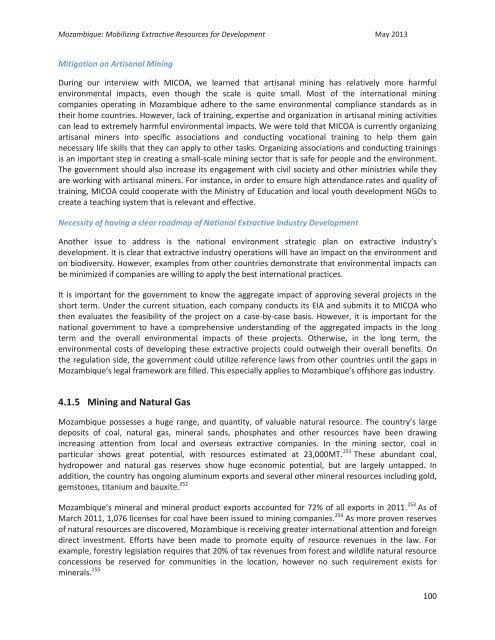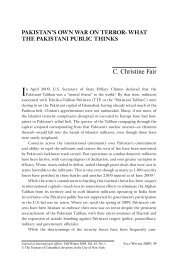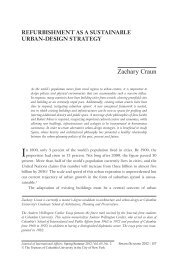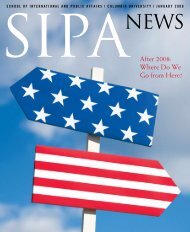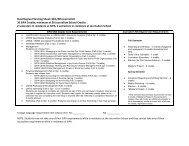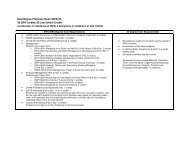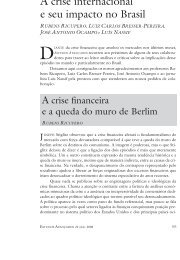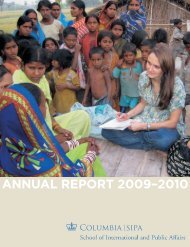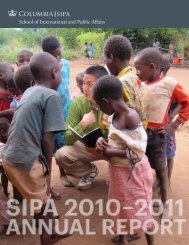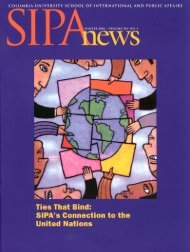Mozambique - School of International and Public Affairs - Columbia ...
Mozambique - School of International and Public Affairs - Columbia ...
Mozambique - School of International and Public Affairs - Columbia ...
You also want an ePaper? Increase the reach of your titles
YUMPU automatically turns print PDFs into web optimized ePapers that Google loves.
<strong>Mozambique</strong>: Mobilizing Extractive Resources for Development May 2013<br />
Mitigation on Artisanal Mining<br />
During our interview with MICOA, we learned that artisanal mining has relatively more harmful<br />
environmental impacts, even though the scale is quite small. Most <strong>of</strong> the international mining<br />
companies operating in <strong>Mozambique</strong> adhere to the same environmental compliance st<strong>and</strong>ards as in<br />
their home countries. However, lack <strong>of</strong> training, expertise <strong>and</strong> organization in artisanal mining activities<br />
can lead to extremely harmful environmental impacts. We were told that MICOA is currently organizing<br />
artisanal miners into specific associations <strong>and</strong> conducting vocational training to help them gain<br />
necessary life skills that they can apply to other tasks. Organizing associations <strong>and</strong> conducting trainings<br />
is an important step in creating a small-scale mining sector that is safe for people <strong>and</strong> the environment.<br />
The government should also increase its engagement with civil society <strong>and</strong> other ministries while they<br />
are working with artisanal miners. For instance, in order to ensure high attendance rates <strong>and</strong> quality <strong>of</strong><br />
training, MICOA could cooperate with the Ministry <strong>of</strong> Education <strong>and</strong> local youth development NGOs to<br />
create a teaching system that is relevant <strong>and</strong> effective.<br />
Necessity <strong>of</strong> having a clear roadmap <strong>of</strong> National Extractive Industry Development<br />
Another issue to address is the national environment strategic plan on extractive industry’s<br />
development. It is clear that extractive industry operations will have an impact on the environment <strong>and</strong><br />
on biodiversity. However, examples from other countries demonstrate that environmental impacts can<br />
be minimized if companies are willing to apply the best international practices.<br />
It is important for the government to know the aggregate impact <strong>of</strong> approving several projects in the<br />
short term. Under the current situation, each company conducts its EIA <strong>and</strong> submits it to MICOA who<br />
then evaluates the feasibility <strong>of</strong> the project on a case-by-case basis. However, it is important for the<br />
national government to have a comprehensive underst<strong>and</strong>ing <strong>of</strong> the aggregated impacts in the long<br />
term <strong>and</strong> the overall environmental impacts <strong>of</strong> these projects. Otherwise, in the long term, the<br />
environmental costs <strong>of</strong> developing these extractive projects could outweigh their overall benefits. On<br />
the regulation side, the government could utilize reference laws from other countries until the gaps in<br />
<strong>Mozambique</strong>’s legal framework are filled. This especially applies to <strong>Mozambique</strong>’s <strong>of</strong>fshore gas industry.<br />
4.1.5 Mining <strong>and</strong> Natural Gas<br />
<strong>Mozambique</strong> possesses a huge range, <strong>and</strong> quantity, <strong>of</strong> valuable natural resource. The country’s large<br />
deposits <strong>of</strong> coal, natural gas, mineral s<strong>and</strong>s, phosphates <strong>and</strong> other resources have been drawing<br />
increasing attention from local <strong>and</strong> overseas extractive companies. In the mining sector, coal in<br />
particular shows great potential, with resources estimated at 23,000MT. 251 These abundant coal,<br />
hydropower <strong>and</strong> natural gas reserves show huge economic potential, but are largely untapped. In<br />
addition, the country has ongoing aluminum exports <strong>and</strong> several other mineral resources including gold,<br />
gemstones, titanium <strong>and</strong> bauxite. 252<br />
<strong>Mozambique</strong>’s mineral <strong>and</strong> mineral product exports accounted for 72% <strong>of</strong> all exports in 2011. 253 As <strong>of</strong><br />
March 2011, 1,076 licenses for coal have been issued to mining companies. 254 As more proven reserves<br />
<strong>of</strong> natural resources are discovered, <strong>Mozambique</strong> is receiving greater international attention <strong>and</strong> foreign<br />
direct investment. Efforts have been made to promote equity <strong>of</strong> resource revenues in the law. For<br />
example, forestry legislation requires that 20% <strong>of</strong> tax revenues from forest <strong>and</strong> wildlife natural resource<br />
concessions be reserved for communities in the location, however no such requirement exists for<br />
minerals. 255<br />
100


